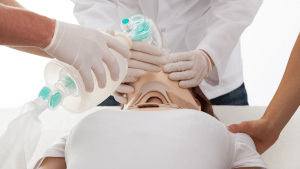How to Perform CPR in Pregnant Women

Although not a common occurrence, the question still remains, how would you give CPR on a pregnant woman?
There are no great studies in CPR on pregnant women, but we have gained a small understanding on the differences between giving CPR to an adult or an adult who is pregnant or heavily pregnant.
Studies have been done on manikins of pregnant women who have not been in cardiac arrest.
In either situation, CPR should be given immediately, the same as any other person who is not breathing and unresponsive, with one important difference.
If a woman is noticeably pregnant, a rolled up towel or pillow should be placed under her right hip to tilt her hips over to the left. This will tilt her uterus to the left, which moves the uterus off of the major blood vessels in the abdomen. Anyone who has been pregnant will know just how uncomfortable it can be to lie flat on your back, it can even make you quite dizzy when that blood flow is compromised.
The compression of these major blood vessels can reduce the return of blood to the heart and in turn reduce oxygenated blood flow back out of the heart.
Even though her hips are tilted, her shoulders should remain square on the floor and CPR should be performed as normal.
A woman’s heart works harder during pregnancy. Her blood volume may increase by 30-50% during pregnancy due to the rate a baby grows in utero. This can cause an extra strain on the woman’s system. A pregnant woman’s heart rate may increase by 15-20 beats per minute during pregnancy too.
This is why some specific medical conditions may appear during pregnancy.
How Often Do We Use CPR In Pregnanct Women?
Maternal cardiac arrest happens in 1 in 30,000 pregnancies, so although rare, it is important to know how to tackle this unique situation.
It is important to also note that if the safe delivery of a baby is going to be attempted after a maternal cardiac arrest, this should optimally take place within 5 minutes, so time is even more crucial in this particular medical emergency where two lives are at risk. Often the maternal collapse won’t happen in a hospital or near medical professionals, making this time frame even harder to achieve.
When a woman is pregnant, the body creates a system where the baby can draw more oxygen from the mother if needed. In the case of maternal collapse, the CPR that is given would not be as effective in delivering the oxygen to the mothers vital organs as the foetus may be drawing it in, preventing optimal oxygenation to the mother.

For this reason alone, it would always be best to have at least two people on the scene performing CPR on a pregnant person, as the compressions and breaths would need to remain as optimal and efficient as possible to accommodate the different anatomy and physiology of a pregnant woman.
How to perform CPR for pregnant women
CPR should be performed at a rate of 30 chest compressions to 2 rescue breaths.
Rescue breaths should be performed on a casualty if the rescuer is trained, willing and able to perform them adequately. Otherwise continuous chest compressions should be delivered. Alternatively a resus face mask can be used to protect the patient and the rescuer equally. A casualty may vomit during an arrest or during recovery so a face mask would protect the rescuer from potential exposure to contaminated bodily fluid, especially in these times of COVID-19.
Chest compressions should be performed once the pregnant person has the towel or cushion placed under her right hip as we mentioned before. The compressions should be performed at 100-120 per minute, but I prefer to teach this as 2 compressions per second. This is much easier to visualise and also is more accurate as 100-120 compressions would not actually be performed in 1 minute as there are breaks for rescue breaths.

Basic Life Support (BLS)
It is important to keep the compressions at a good quality. It is very easy to become tired and fatigued when performing cardiopulmonary resuscitation. It can be extremely exhausting. There is data to show that after 1 minute, CPR does become more shallow because of rescuer fatigue. It is recommended by ANZCOR to change places with another rescuer every two minutes if possible.
Compressions should ideally be the depth of ⅓ depth of the chest. This may be around 5cm or a little more in adults. In children it is still good to aim for around 5ch and infants around 4cm. This is not an exact science as it would be too hard to actually measure obviously, but this is just good to keep in mind.
How to Put a Pregnant Woman in the Recovery Position
This is much the same as a prson who is not pregnant, however there is a difference.
Roll the person onto their left side if possible. Their right knee out at a right angle to stop them roling onto their front. left leg should just be straight.
Their head should be tilted slightly up to allow a clear airway and incase of vomiting. Right hand between the cheek and the floor, palm to the cheek.
Place a towel under the heavily pregnant belly for support.
CPR Training
If you are looking for group workplace first aid, we can accommodate your needs Australia wide. You can choose from various different delivery options from 80% online to 100% full face to face. It’s entirely up to you and how your workforce would best learn.
Contact us today or simply book via our website and we will be in touch within 24 hours to lock in a date for you. We can’t wait to meet you!

